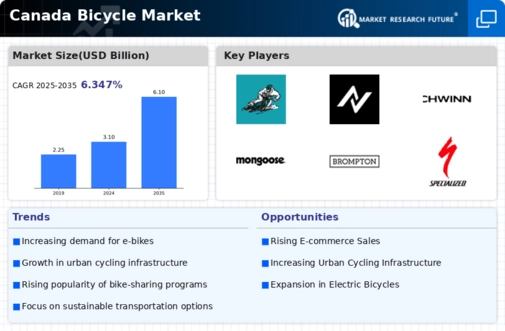Government Initiatives and Incentives
Government policies and initiatives play a crucial role in shaping the bicycle market in Canada. Various provincial and federal programs are designed to promote cycling as a viable transportation option. For instance, subsidies for electric bicycles and tax incentives for purchasing bicycles are becoming more common. In 2025, it is estimated that government funding for cycling infrastructure will reach approximately $200 million, reflecting a commitment to enhancing cycling facilities. These initiatives not only encourage more individuals to consider cycling but also contribute to the overall growth of the bicycle market by making it more financially accessible.
Rising Fuel Prices and Economic Factors
Economic conditions, particularly rising fuel prices, are influencing consumer behavior in Canada, thereby impacting the bicycle market. As fuel costs continue to escalate, many Canadians are seeking cost-effective alternatives for commuting and leisure activities. The bicycle market is likely to see a surge in demand as individuals look to bicycles as a means to save on transportation expenses. In 2025, it is projected that the average price of gasoline will exceed $1.80 per liter, prompting more consumers to consider cycling as a viable option. This economic shift could lead to a significant increase in bicycle sales and usage across the country.
Environmental Awareness and Climate Change
Growing environmental awareness among Canadians is driving a shift towards more sustainable transportation methods, including cycling. The bicycle market is benefiting from an increasing recognition of the need to reduce carbon footprints and combat climate change. Surveys indicate that over 60% of Canadians are willing to switch to cycling for short trips to minimize their environmental impact. This heightened awareness is likely to lead to a sustained increase in bicycle sales and usage, as consumers seek eco-friendly alternatives. Consequently, the bicycle market is positioned to thrive as more individuals prioritize sustainability in their transportation choices.
Technological Innovations in Bicycle Design
Technological advancements in bicycle design and manufacturing are emerging as a key driver for the bicycle market in Canada. Innovations such as lightweight materials, improved gear systems, and enhanced safety features are making bicycles more appealing to a broader audience. The introduction of smart bicycles equipped with GPS and connectivity features is also gaining traction. As consumers become more tech-savvy, the demand for high-performance bicycles is likely to increase. In 2025, it is estimated that the market for electric bicycles alone will grow by 25%, reflecting the impact of these technological innovations on consumer preferences and the overall bicycle market.
Urbanization and Infrastructure Development
The ongoing trend of urbanization in Canada appears to be a significant driver for the bicycle market. As cities expand and populations increase, the demand for efficient and sustainable transportation options rises. Municipalities are investing in cycling infrastructure, such as dedicated bike lanes and bike-sharing programs, which enhances accessibility and safety for cyclists. According to recent data, urban areas with well-developed cycling infrastructure have seen a 30% increase in bicycle usage. This shift towards cycling as a primary mode of transport not only alleviates traffic congestion but also promotes environmental sustainability, thereby positively impacting the bicycle market.





















Leave a Comment